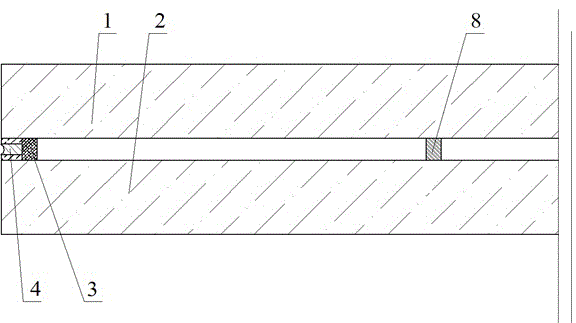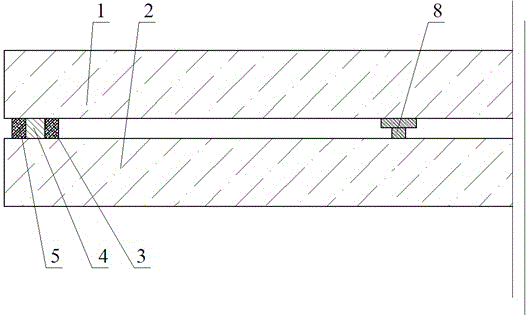Vacuum glass with two or a plurality of paths of sealing and a preparing method thereof
A vacuum glass and glass technology, applied in glass manufacturing equipment, glass production, glass molding, etc., can solve the problems of broken supports and glass, difficulty in maintaining vacuum degree, and low production capacity
- Summary
- Abstract
- Description
- Claims
- Application Information
AI Technical Summary
Problems solved by technology
Method used
Image
Examples
Embodiment 1
[0098] Example 1: see figure 1 , a convex vacuum glass with two seals. The vacuum glass is composed of an upper convex glass 1 and a lower convex glass 2. The periphery of the two glasses is welded together by the first sealing 3 low-temperature glass solder and the second sealing 4 metal solder. , with a vacuum layer in the middle. The production method is as follows: firstly cut two pieces of flat glass of the required size according to the shape and size of the vacuum glass to be produced, and perform edge grinding, chamfering, cleaning and drying; secondly, apply silver paste on the welding surface of the metal solder, Then put the two pieces of glass into the mold, put them in the hot bending furnace, heat up to the softening temperature of the glass at 550-750°C, rely on the gravity of the glass itself to make the glass downward to form a convex surface, and the coated silver paste is also sintered on the glass , and lowered to room temperature with the furnace; again, ...
Embodiment 2
[0100] Example 2: see figure 2 , a flat vacuum glass with two seals, the two glasses are tempered glass, one of which is low-emissivity glass; the vacuum glass is composed of upper glass 1 and lower glass 2, and the periphery of the two glasses is sealed by the first 3 polyamide The imide adhesive and the second seal 4 metal solder are welded together with a vacuum layer in between. The production method is as follows: first, cut two pieces of flat glass of the required size according to the shape and size of the vacuum glass to be produced, and perform edge grinding, chamfering, cleaning and drying; secondly, use tempered glass ink and dots on the upper glass 1 The glue machine prepares the support 8, coats the silver paste on the welding surface of the metal solder of the two glasses, and then sends the two glasses into the tempering furnace for tempering treatment, the prepared support 8 and the coated silver paste It is also sintered on the glass; the sintered support 8 ...
Embodiment 3
[0102] Embodiment 3: see image 3 , a three-way sealed planar vacuum glass, two pieces of glass are tempered glass, one of which is still low-emissivity glass, and its production method is as follows: First, cut a piece of flat glass and a piece of required size according to the shape and size of the vacuum glass to be produced. Low-emissivity glass, and carry out edging, chamfering, cleaning, and drying; secondly, on the two pieces of glass, use tempered glass ink and a glue dispenser to prepare the support 8 respectively, and the support 8 is a long strip. After the two pieces of glass are combined The upper and lower supports are intersected together, and then the two pieces of glass are respectively sent into the tempering furnace for tempering treatment, and the prepared support 8 is also sintered on the glass; the sintered support 8 is mechanically ground again to make the top of it on the In one plane, round the top edge after grinding to further eliminate the influence...
PUM
| Property | Measurement | Unit |
|---|---|---|
| softening point | aaaaa | aaaaa |
| height | aaaaa | aaaaa |
| width | aaaaa | aaaaa |
Abstract
Description
Claims
Application Information
 Login to View More
Login to View More - R&D
- Intellectual Property
- Life Sciences
- Materials
- Tech Scout
- Unparalleled Data Quality
- Higher Quality Content
- 60% Fewer Hallucinations
Browse by: Latest US Patents, China's latest patents, Technical Efficacy Thesaurus, Application Domain, Technology Topic, Popular Technical Reports.
© 2025 PatSnap. All rights reserved.Legal|Privacy policy|Modern Slavery Act Transparency Statement|Sitemap|About US| Contact US: help@patsnap.com



